Deakin University MAF203 Business Finance Assignment Solution - 2019
VerifiedAdded on 2022/12/30
|12
|2605
|1
Homework Assignment
AI Summary
This document presents a comprehensive solution to a business finance assignment, focusing on capital budgeting and financial decision-making. The solution includes detailed calculations for Net Present Value (NPV) and Internal Rate of Return (IRR), assessing the viability of a project. It also explores the concept of hurdle rates and their implications on investment decisions, differentiating them from discount rates. Furthermore, the assignment incorporates sensitivity analysis to evaluate the impact of changes in sales, costs, and the cost of capital on the project's profitability. The analysis extends to discussing the paper and pulp industry's challenges, including technological obsolescence, climate change, and government regulations, and their effect on the industry's growth. The solution provides a thorough understanding of financial concepts and their practical application in real-world business scenarios, making it a valuable resource for students studying business finance.
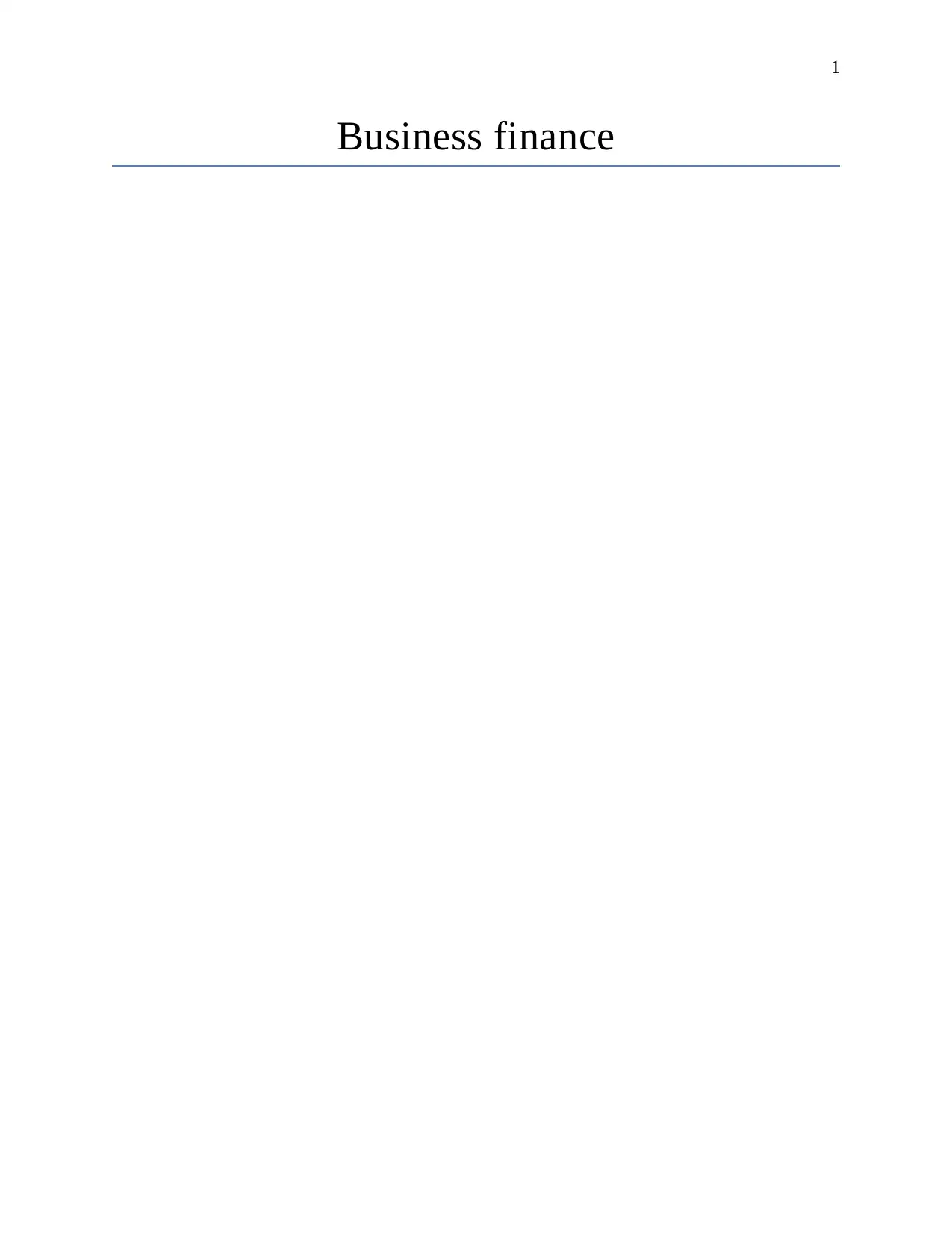
1
Business finance
Business finance
Paraphrase This Document
Need a fresh take? Get an instant paraphrase of this document with our AI Paraphraser
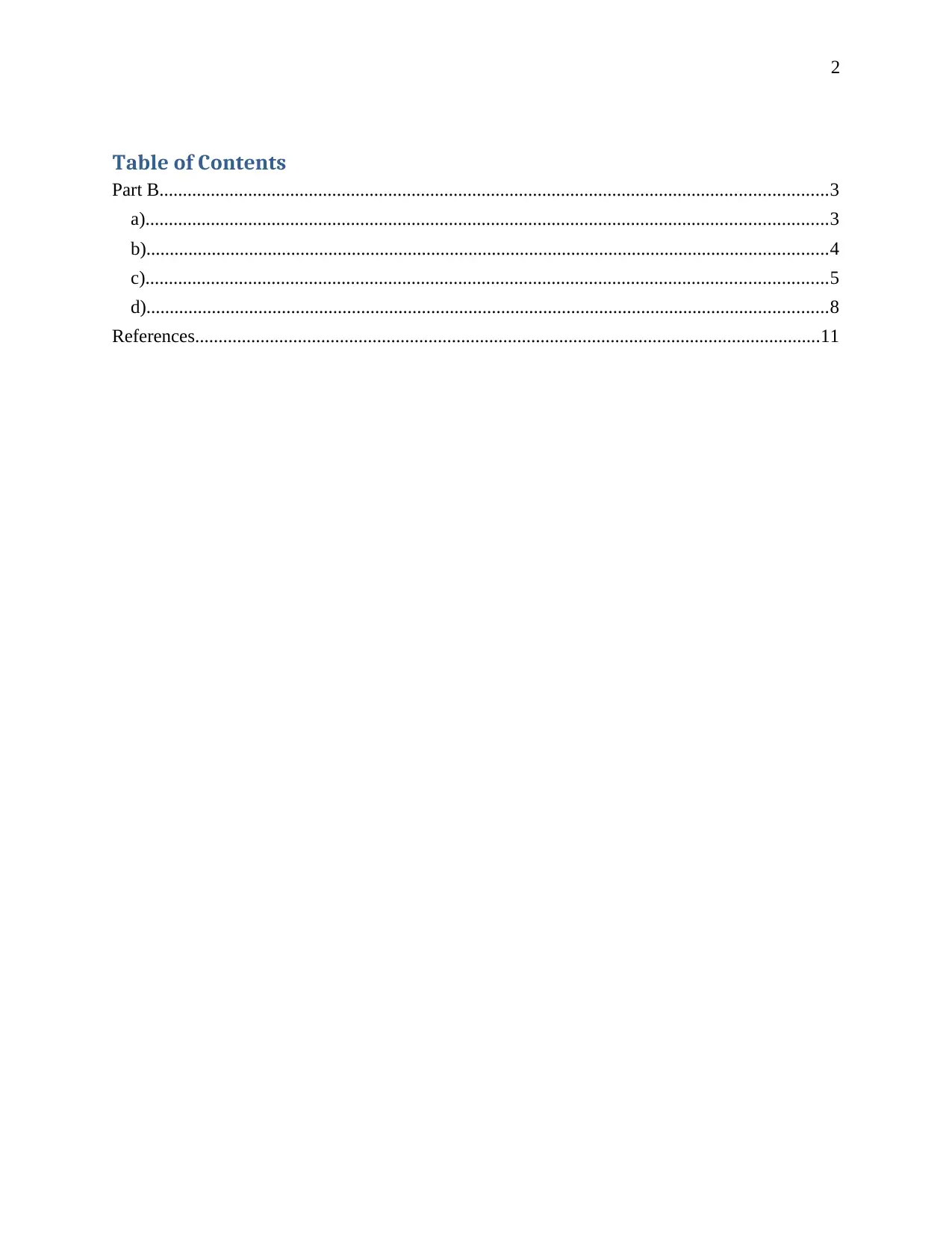
2
Table of Contents
Part B...............................................................................................................................................3
a)..................................................................................................................................................3
b)..................................................................................................................................................4
c)..................................................................................................................................................5
d)..................................................................................................................................................8
References......................................................................................................................................11
Table of Contents
Part B...............................................................................................................................................3
a)..................................................................................................................................................3
b)..................................................................................................................................................4
c)..................................................................................................................................................5
d)..................................................................................................................................................8
References......................................................................................................................................11
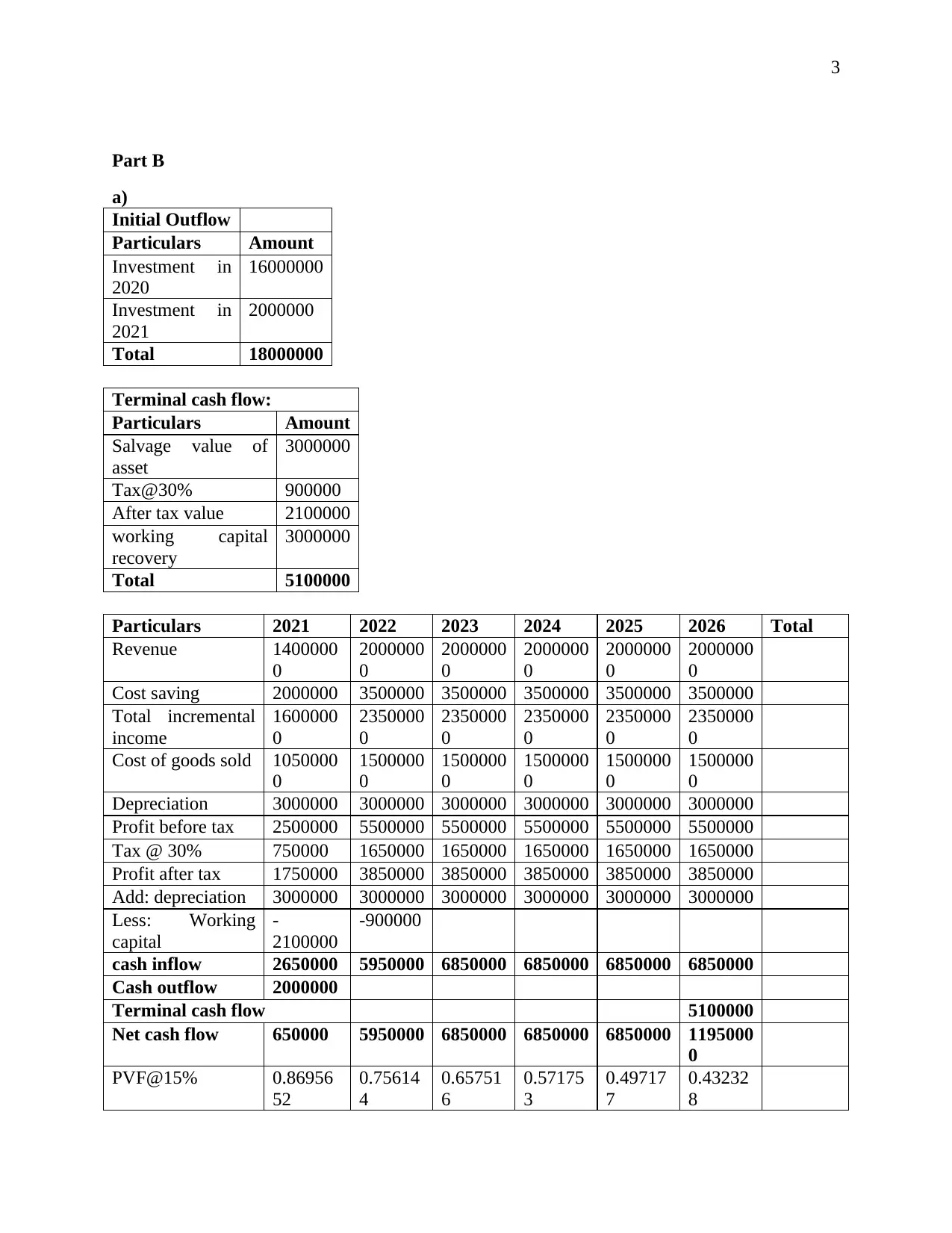
3
Part B
a)
Initial Outflow
Particulars Amount
Investment in
2020
16000000
Investment in
2021
2000000
Total 18000000
Terminal cash flow:
Particulars Amount
Salvage value of
asset
3000000
Tax@30% 900000
After tax value 2100000
working capital
recovery
3000000
Total 5100000
Particulars 2021 2022 2023 2024 2025 2026 Total
Revenue 1400000
0
2000000
0
2000000
0
2000000
0
2000000
0
2000000
0
Cost saving 2000000 3500000 3500000 3500000 3500000 3500000
Total incremental
income
1600000
0
2350000
0
2350000
0
2350000
0
2350000
0
2350000
0
Cost of goods sold 1050000
0
1500000
0
1500000
0
1500000
0
1500000
0
1500000
0
Depreciation 3000000 3000000 3000000 3000000 3000000 3000000
Profit before tax 2500000 5500000 5500000 5500000 5500000 5500000
Tax @ 30% 750000 1650000 1650000 1650000 1650000 1650000
Profit after tax 1750000 3850000 3850000 3850000 3850000 3850000
Add: depreciation 3000000 3000000 3000000 3000000 3000000 3000000
Less: Working
capital
-
2100000
-900000
cash inflow 2650000 5950000 6850000 6850000 6850000 6850000
Cash outflow 2000000
Terminal cash flow 5100000
Net cash flow 650000 5950000 6850000 6850000 6850000 1195000
0
PVF@15% 0.86956
52
0.75614
4
0.65751
6
0.57175
3
0.49717
7
0.43232
8
Part B
a)
Initial Outflow
Particulars Amount
Investment in
2020
16000000
Investment in
2021
2000000
Total 18000000
Terminal cash flow:
Particulars Amount
Salvage value of
asset
3000000
Tax@30% 900000
After tax value 2100000
working capital
recovery
3000000
Total 5100000
Particulars 2021 2022 2023 2024 2025 2026 Total
Revenue 1400000
0
2000000
0
2000000
0
2000000
0
2000000
0
2000000
0
Cost saving 2000000 3500000 3500000 3500000 3500000 3500000
Total incremental
income
1600000
0
2350000
0
2350000
0
2350000
0
2350000
0
2350000
0
Cost of goods sold 1050000
0
1500000
0
1500000
0
1500000
0
1500000
0
1500000
0
Depreciation 3000000 3000000 3000000 3000000 3000000 3000000
Profit before tax 2500000 5500000 5500000 5500000 5500000 5500000
Tax @ 30% 750000 1650000 1650000 1650000 1650000 1650000
Profit after tax 1750000 3850000 3850000 3850000 3850000 3850000
Add: depreciation 3000000 3000000 3000000 3000000 3000000 3000000
Less: Working
capital
-
2100000
-900000
cash inflow 2650000 5950000 6850000 6850000 6850000 6850000
Cash outflow 2000000
Terminal cash flow 5100000
Net cash flow 650000 5950000 6850000 6850000 6850000 1195000
0
PVF@15% 0.86956
52
0.75614
4
0.65751
6
0.57175
3
0.49717
7
0.43232
8
⊘ This is a preview!⊘
Do you want full access?
Subscribe today to unlock all pages.

Trusted by 1+ million students worldwide
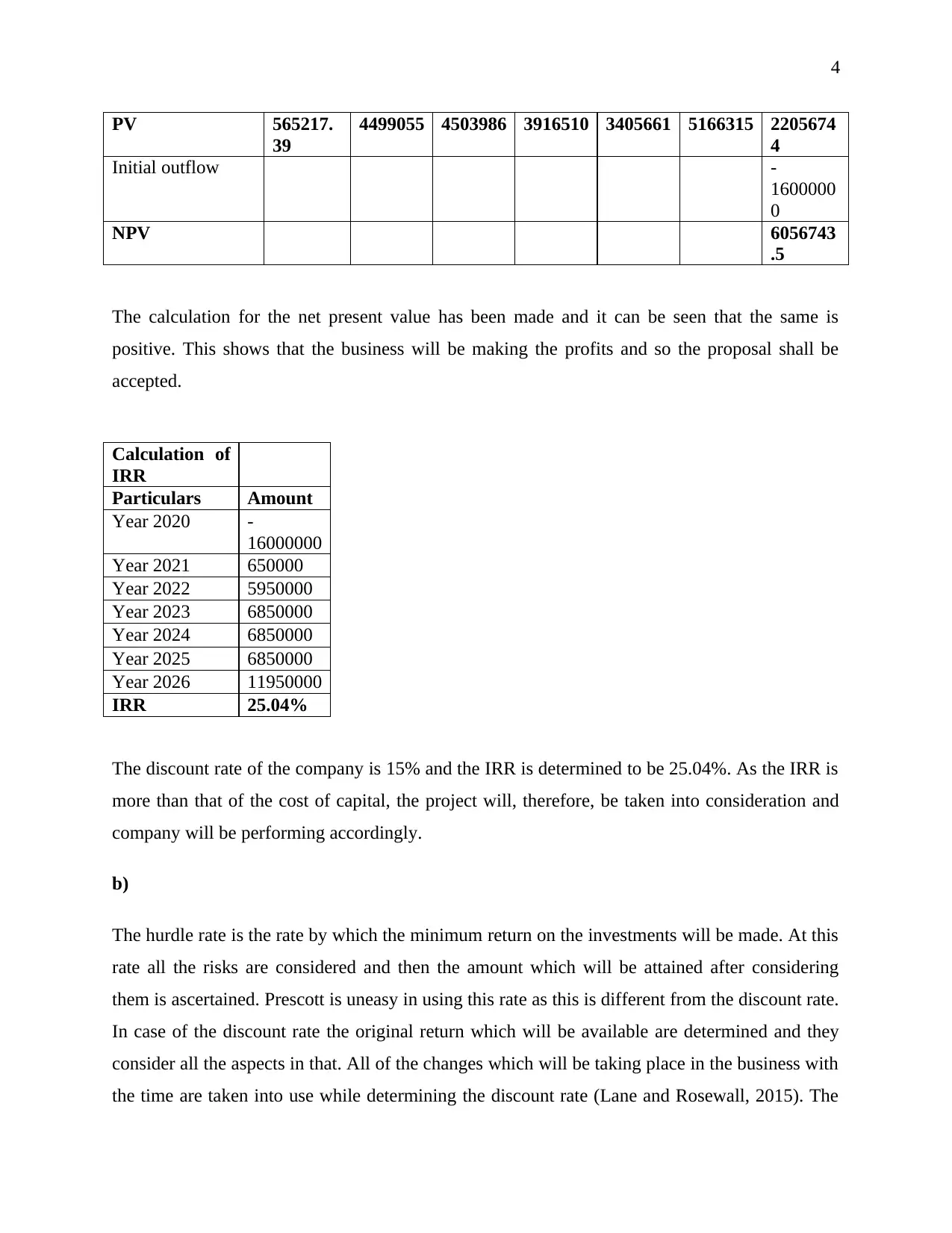
4
PV 565217.
39
4499055 4503986 3916510 3405661 5166315 2205674
4
Initial outflow -
1600000
0
NPV 6056743
.5
The calculation for the net present value has been made and it can be seen that the same is
positive. This shows that the business will be making the profits and so the proposal shall be
accepted.
Calculation of
IRR
Particulars Amount
Year 2020 -
16000000
Year 2021 650000
Year 2022 5950000
Year 2023 6850000
Year 2024 6850000
Year 2025 6850000
Year 2026 11950000
IRR 25.04%
The discount rate of the company is 15% and the IRR is determined to be 25.04%. As the IRR is
more than that of the cost of capital, the project will, therefore, be taken into consideration and
company will be performing accordingly.
b)
The hurdle rate is the rate by which the minimum return on the investments will be made. At this
rate all the risks are considered and then the amount which will be attained after considering
them is ascertained. Prescott is uneasy in using this rate as this is different from the discount rate.
In case of the discount rate the original return which will be available are determined and they
consider all the aspects in that. All of the changes which will be taking place in the business with
the time are taken into use while determining the discount rate (Lane and Rosewall, 2015). The
PV 565217.
39
4499055 4503986 3916510 3405661 5166315 2205674
4
Initial outflow -
1600000
0
NPV 6056743
.5
The calculation for the net present value has been made and it can be seen that the same is
positive. This shows that the business will be making the profits and so the proposal shall be
accepted.
Calculation of
IRR
Particulars Amount
Year 2020 -
16000000
Year 2021 650000
Year 2022 5950000
Year 2023 6850000
Year 2024 6850000
Year 2025 6850000
Year 2026 11950000
IRR 25.04%
The discount rate of the company is 15% and the IRR is determined to be 25.04%. As the IRR is
more than that of the cost of capital, the project will, therefore, be taken into consideration and
company will be performing accordingly.
b)
The hurdle rate is the rate by which the minimum return on the investments will be made. At this
rate all the risks are considered and then the amount which will be attained after considering
them is ascertained. Prescott is uneasy in using this rate as this is different from the discount rate.
In case of the discount rate the original return which will be available are determined and they
consider all the aspects in that. All of the changes which will be taking place in the business with
the time are taken into use while determining the discount rate (Lane and Rosewall, 2015). The
Paraphrase This Document
Need a fresh take? Get an instant paraphrase of this document with our AI Paraphraser
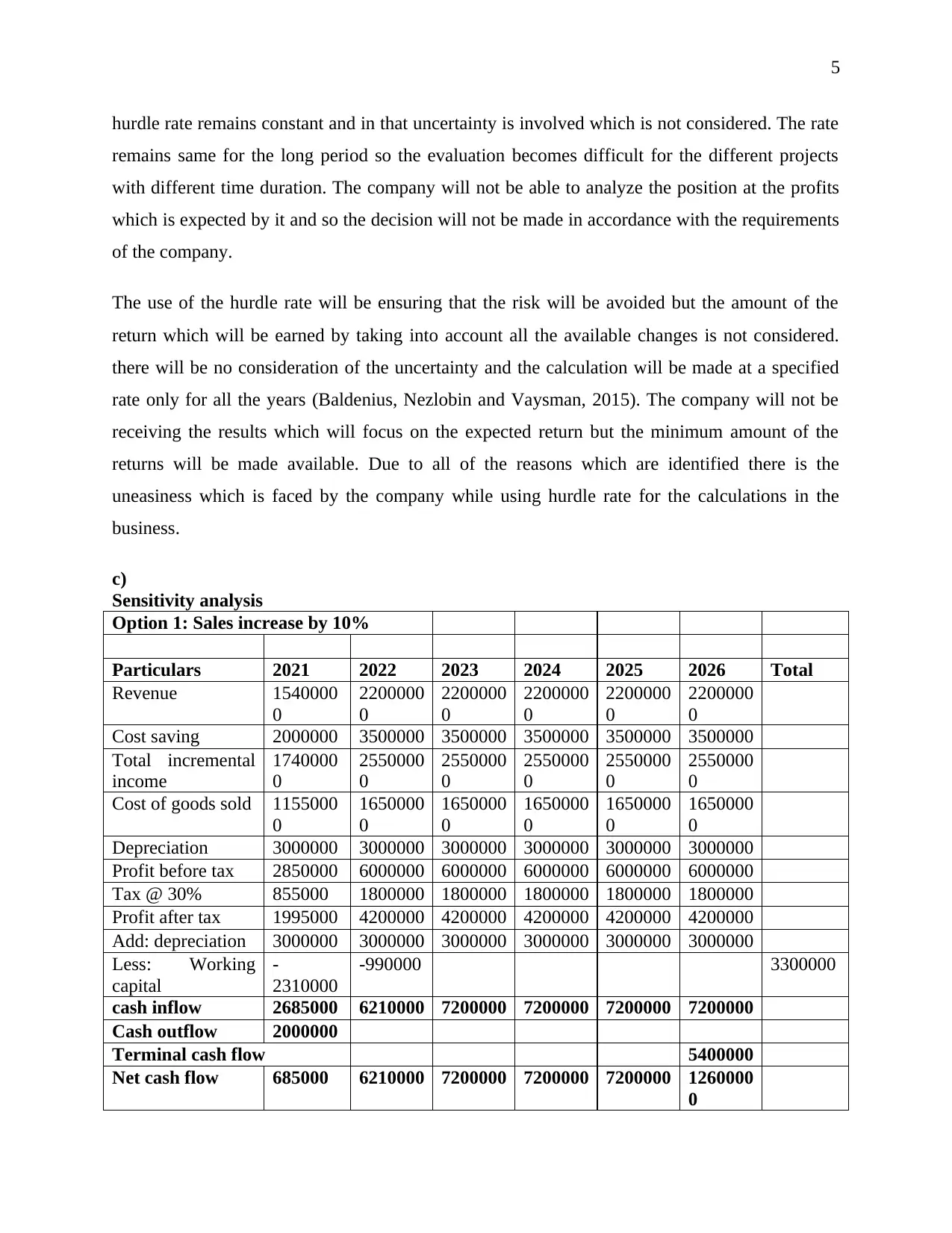
5
hurdle rate remains constant and in that uncertainty is involved which is not considered. The rate
remains same for the long period so the evaluation becomes difficult for the different projects
with different time duration. The company will not be able to analyze the position at the profits
which is expected by it and so the decision will not be made in accordance with the requirements
of the company.
The use of the hurdle rate will be ensuring that the risk will be avoided but the amount of the
return which will be earned by taking into account all the available changes is not considered.
there will be no consideration of the uncertainty and the calculation will be made at a specified
rate only for all the years (Baldenius, Nezlobin and Vaysman, 2015). The company will not be
receiving the results which will focus on the expected return but the minimum amount of the
returns will be made available. Due to all of the reasons which are identified there is the
uneasiness which is faced by the company while using hurdle rate for the calculations in the
business.
c)
Sensitivity analysis
Option 1: Sales increase by 10%
Particulars 2021 2022 2023 2024 2025 2026 Total
Revenue 1540000
0
2200000
0
2200000
0
2200000
0
2200000
0
2200000
0
Cost saving 2000000 3500000 3500000 3500000 3500000 3500000
Total incremental
income
1740000
0
2550000
0
2550000
0
2550000
0
2550000
0
2550000
0
Cost of goods sold 1155000
0
1650000
0
1650000
0
1650000
0
1650000
0
1650000
0
Depreciation 3000000 3000000 3000000 3000000 3000000 3000000
Profit before tax 2850000 6000000 6000000 6000000 6000000 6000000
Tax @ 30% 855000 1800000 1800000 1800000 1800000 1800000
Profit after tax 1995000 4200000 4200000 4200000 4200000 4200000
Add: depreciation 3000000 3000000 3000000 3000000 3000000 3000000
Less: Working
capital
-
2310000
-990000 3300000
cash inflow 2685000 6210000 7200000 7200000 7200000 7200000
Cash outflow 2000000
Terminal cash flow 5400000
Net cash flow 685000 6210000 7200000 7200000 7200000 1260000
0
hurdle rate remains constant and in that uncertainty is involved which is not considered. The rate
remains same for the long period so the evaluation becomes difficult for the different projects
with different time duration. The company will not be able to analyze the position at the profits
which is expected by it and so the decision will not be made in accordance with the requirements
of the company.
The use of the hurdle rate will be ensuring that the risk will be avoided but the amount of the
return which will be earned by taking into account all the available changes is not considered.
there will be no consideration of the uncertainty and the calculation will be made at a specified
rate only for all the years (Baldenius, Nezlobin and Vaysman, 2015). The company will not be
receiving the results which will focus on the expected return but the minimum amount of the
returns will be made available. Due to all of the reasons which are identified there is the
uneasiness which is faced by the company while using hurdle rate for the calculations in the
business.
c)
Sensitivity analysis
Option 1: Sales increase by 10%
Particulars 2021 2022 2023 2024 2025 2026 Total
Revenue 1540000
0
2200000
0
2200000
0
2200000
0
2200000
0
2200000
0
Cost saving 2000000 3500000 3500000 3500000 3500000 3500000
Total incremental
income
1740000
0
2550000
0
2550000
0
2550000
0
2550000
0
2550000
0
Cost of goods sold 1155000
0
1650000
0
1650000
0
1650000
0
1650000
0
1650000
0
Depreciation 3000000 3000000 3000000 3000000 3000000 3000000
Profit before tax 2850000 6000000 6000000 6000000 6000000 6000000
Tax @ 30% 855000 1800000 1800000 1800000 1800000 1800000
Profit after tax 1995000 4200000 4200000 4200000 4200000 4200000
Add: depreciation 3000000 3000000 3000000 3000000 3000000 3000000
Less: Working
capital
-
2310000
-990000 3300000
cash inflow 2685000 6210000 7200000 7200000 7200000 7200000
Cash outflow 2000000
Terminal cash flow 5400000
Net cash flow 685000 6210000 7200000 7200000 7200000 1260000
0
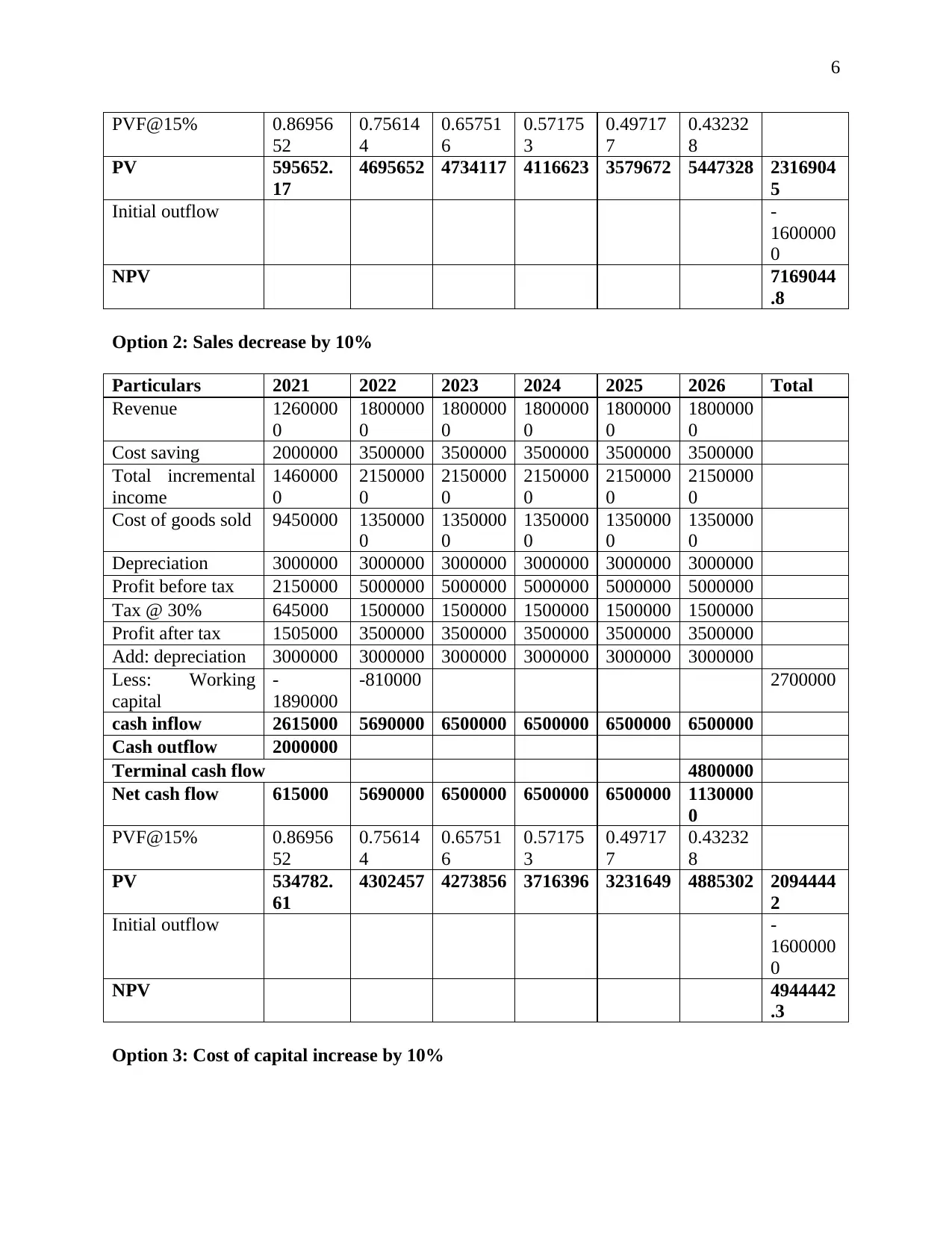
6
PVF@15% 0.86956
52
0.75614
4
0.65751
6
0.57175
3
0.49717
7
0.43232
8
PV 595652.
17
4695652 4734117 4116623 3579672 5447328 2316904
5
Initial outflow -
1600000
0
NPV 7169044
.8
Option 2: Sales decrease by 10%
Particulars 2021 2022 2023 2024 2025 2026 Total
Revenue 1260000
0
1800000
0
1800000
0
1800000
0
1800000
0
1800000
0
Cost saving 2000000 3500000 3500000 3500000 3500000 3500000
Total incremental
income
1460000
0
2150000
0
2150000
0
2150000
0
2150000
0
2150000
0
Cost of goods sold 9450000 1350000
0
1350000
0
1350000
0
1350000
0
1350000
0
Depreciation 3000000 3000000 3000000 3000000 3000000 3000000
Profit before tax 2150000 5000000 5000000 5000000 5000000 5000000
Tax @ 30% 645000 1500000 1500000 1500000 1500000 1500000
Profit after tax 1505000 3500000 3500000 3500000 3500000 3500000
Add: depreciation 3000000 3000000 3000000 3000000 3000000 3000000
Less: Working
capital
-
1890000
-810000 2700000
cash inflow 2615000 5690000 6500000 6500000 6500000 6500000
Cash outflow 2000000
Terminal cash flow 4800000
Net cash flow 615000 5690000 6500000 6500000 6500000 1130000
0
PVF@15% 0.86956
52
0.75614
4
0.65751
6
0.57175
3
0.49717
7
0.43232
8
PV 534782.
61
4302457 4273856 3716396 3231649 4885302 2094444
2
Initial outflow -
1600000
0
NPV 4944442
.3
Option 3: Cost of capital increase by 10%
PVF@15% 0.86956
52
0.75614
4
0.65751
6
0.57175
3
0.49717
7
0.43232
8
PV 595652.
17
4695652 4734117 4116623 3579672 5447328 2316904
5
Initial outflow -
1600000
0
NPV 7169044
.8
Option 2: Sales decrease by 10%
Particulars 2021 2022 2023 2024 2025 2026 Total
Revenue 1260000
0
1800000
0
1800000
0
1800000
0
1800000
0
1800000
0
Cost saving 2000000 3500000 3500000 3500000 3500000 3500000
Total incremental
income
1460000
0
2150000
0
2150000
0
2150000
0
2150000
0
2150000
0
Cost of goods sold 9450000 1350000
0
1350000
0
1350000
0
1350000
0
1350000
0
Depreciation 3000000 3000000 3000000 3000000 3000000 3000000
Profit before tax 2150000 5000000 5000000 5000000 5000000 5000000
Tax @ 30% 645000 1500000 1500000 1500000 1500000 1500000
Profit after tax 1505000 3500000 3500000 3500000 3500000 3500000
Add: depreciation 3000000 3000000 3000000 3000000 3000000 3000000
Less: Working
capital
-
1890000
-810000 2700000
cash inflow 2615000 5690000 6500000 6500000 6500000 6500000
Cash outflow 2000000
Terminal cash flow 4800000
Net cash flow 615000 5690000 6500000 6500000 6500000 1130000
0
PVF@15% 0.86956
52
0.75614
4
0.65751
6
0.57175
3
0.49717
7
0.43232
8
PV 534782.
61
4302457 4273856 3716396 3231649 4885302 2094444
2
Initial outflow -
1600000
0
NPV 4944442
.3
Option 3: Cost of capital increase by 10%
⊘ This is a preview!⊘
Do you want full access?
Subscribe today to unlock all pages.

Trusted by 1+ million students worldwide
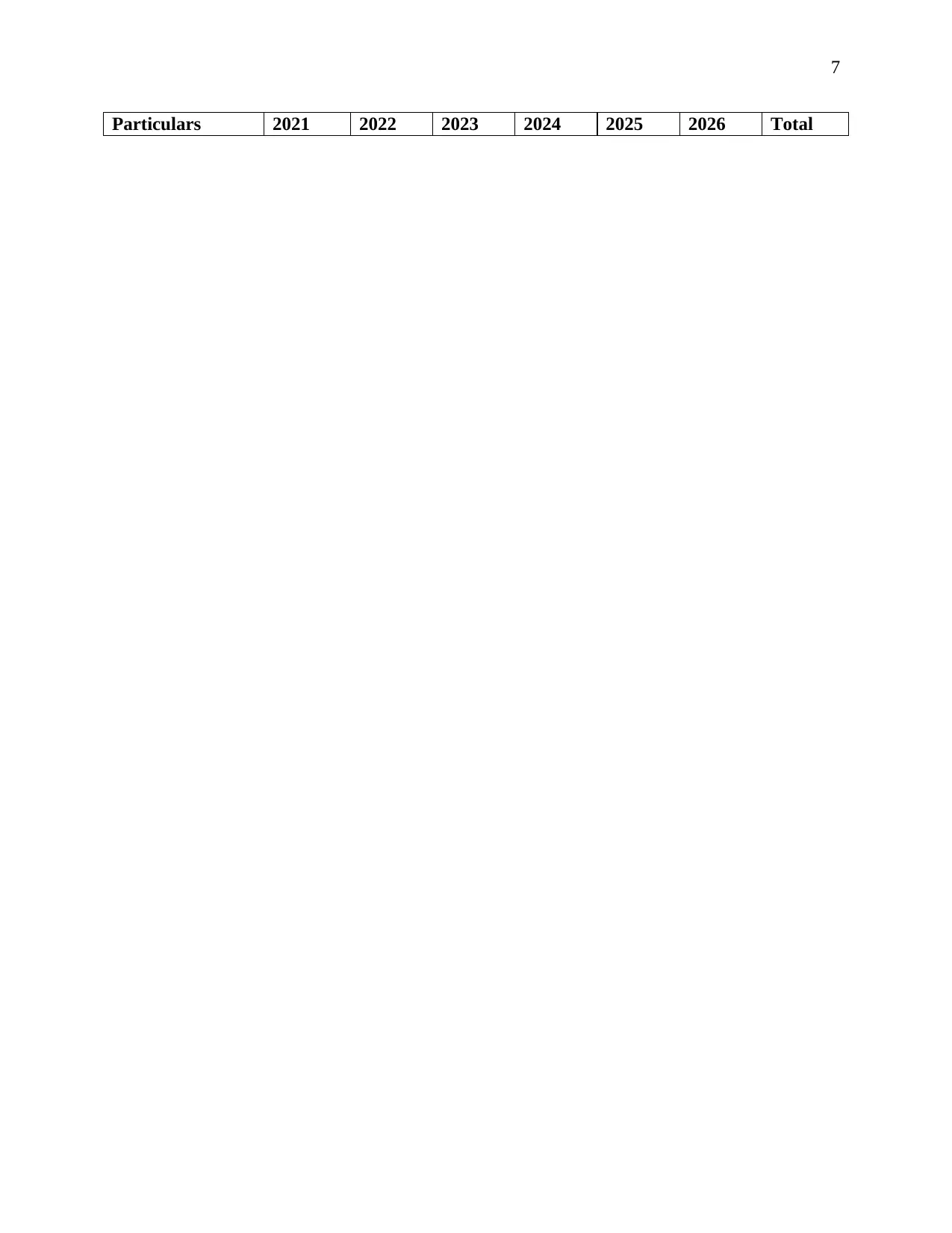
7
Particulars 2021 2022 2023 2024 2025 2026 Total
Particulars 2021 2022 2023 2024 2025 2026 Total
Paraphrase This Document
Need a fresh take? Get an instant paraphrase of this document with our AI Paraphraser
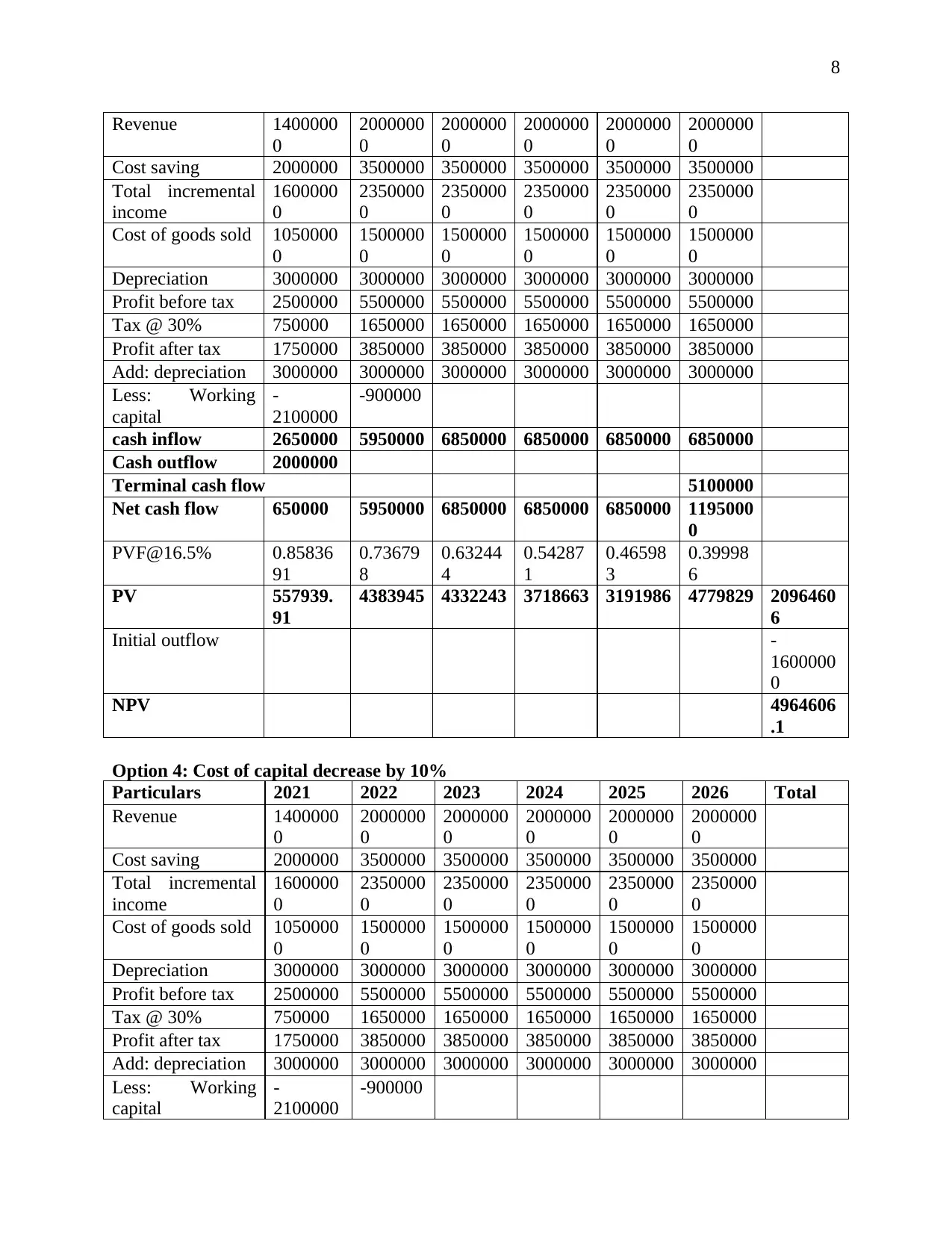
8
Revenue 1400000
0
2000000
0
2000000
0
2000000
0
2000000
0
2000000
0
Cost saving 2000000 3500000 3500000 3500000 3500000 3500000
Total incremental
income
1600000
0
2350000
0
2350000
0
2350000
0
2350000
0
2350000
0
Cost of goods sold 1050000
0
1500000
0
1500000
0
1500000
0
1500000
0
1500000
0
Depreciation 3000000 3000000 3000000 3000000 3000000 3000000
Profit before tax 2500000 5500000 5500000 5500000 5500000 5500000
Tax @ 30% 750000 1650000 1650000 1650000 1650000 1650000
Profit after tax 1750000 3850000 3850000 3850000 3850000 3850000
Add: depreciation 3000000 3000000 3000000 3000000 3000000 3000000
Less: Working
capital
-
2100000
-900000
cash inflow 2650000 5950000 6850000 6850000 6850000 6850000
Cash outflow 2000000
Terminal cash flow 5100000
Net cash flow 650000 5950000 6850000 6850000 6850000 1195000
0
PVF@16.5% 0.85836
91
0.73679
8
0.63244
4
0.54287
1
0.46598
3
0.39998
6
PV 557939.
91
4383945 4332243 3718663 3191986 4779829 2096460
6
Initial outflow -
1600000
0
NPV 4964606
.1
Option 4: Cost of capital decrease by 10%
Particulars 2021 2022 2023 2024 2025 2026 Total
Revenue 1400000
0
2000000
0
2000000
0
2000000
0
2000000
0
2000000
0
Cost saving 2000000 3500000 3500000 3500000 3500000 3500000
Total incremental
income
1600000
0
2350000
0
2350000
0
2350000
0
2350000
0
2350000
0
Cost of goods sold 1050000
0
1500000
0
1500000
0
1500000
0
1500000
0
1500000
0
Depreciation 3000000 3000000 3000000 3000000 3000000 3000000
Profit before tax 2500000 5500000 5500000 5500000 5500000 5500000
Tax @ 30% 750000 1650000 1650000 1650000 1650000 1650000
Profit after tax 1750000 3850000 3850000 3850000 3850000 3850000
Add: depreciation 3000000 3000000 3000000 3000000 3000000 3000000
Less: Working
capital
-
2100000
-900000
Revenue 1400000
0
2000000
0
2000000
0
2000000
0
2000000
0
2000000
0
Cost saving 2000000 3500000 3500000 3500000 3500000 3500000
Total incremental
income
1600000
0
2350000
0
2350000
0
2350000
0
2350000
0
2350000
0
Cost of goods sold 1050000
0
1500000
0
1500000
0
1500000
0
1500000
0
1500000
0
Depreciation 3000000 3000000 3000000 3000000 3000000 3000000
Profit before tax 2500000 5500000 5500000 5500000 5500000 5500000
Tax @ 30% 750000 1650000 1650000 1650000 1650000 1650000
Profit after tax 1750000 3850000 3850000 3850000 3850000 3850000
Add: depreciation 3000000 3000000 3000000 3000000 3000000 3000000
Less: Working
capital
-
2100000
-900000
cash inflow 2650000 5950000 6850000 6850000 6850000 6850000
Cash outflow 2000000
Terminal cash flow 5100000
Net cash flow 650000 5950000 6850000 6850000 6850000 1195000
0
PVF@16.5% 0.85836
91
0.73679
8
0.63244
4
0.54287
1
0.46598
3
0.39998
6
PV 557939.
91
4383945 4332243 3718663 3191986 4779829 2096460
6
Initial outflow -
1600000
0
NPV 4964606
.1
Option 4: Cost of capital decrease by 10%
Particulars 2021 2022 2023 2024 2025 2026 Total
Revenue 1400000
0
2000000
0
2000000
0
2000000
0
2000000
0
2000000
0
Cost saving 2000000 3500000 3500000 3500000 3500000 3500000
Total incremental
income
1600000
0
2350000
0
2350000
0
2350000
0
2350000
0
2350000
0
Cost of goods sold 1050000
0
1500000
0
1500000
0
1500000
0
1500000
0
1500000
0
Depreciation 3000000 3000000 3000000 3000000 3000000 3000000
Profit before tax 2500000 5500000 5500000 5500000 5500000 5500000
Tax @ 30% 750000 1650000 1650000 1650000 1650000 1650000
Profit after tax 1750000 3850000 3850000 3850000 3850000 3850000
Add: depreciation 3000000 3000000 3000000 3000000 3000000 3000000
Less: Working
capital
-
2100000
-900000
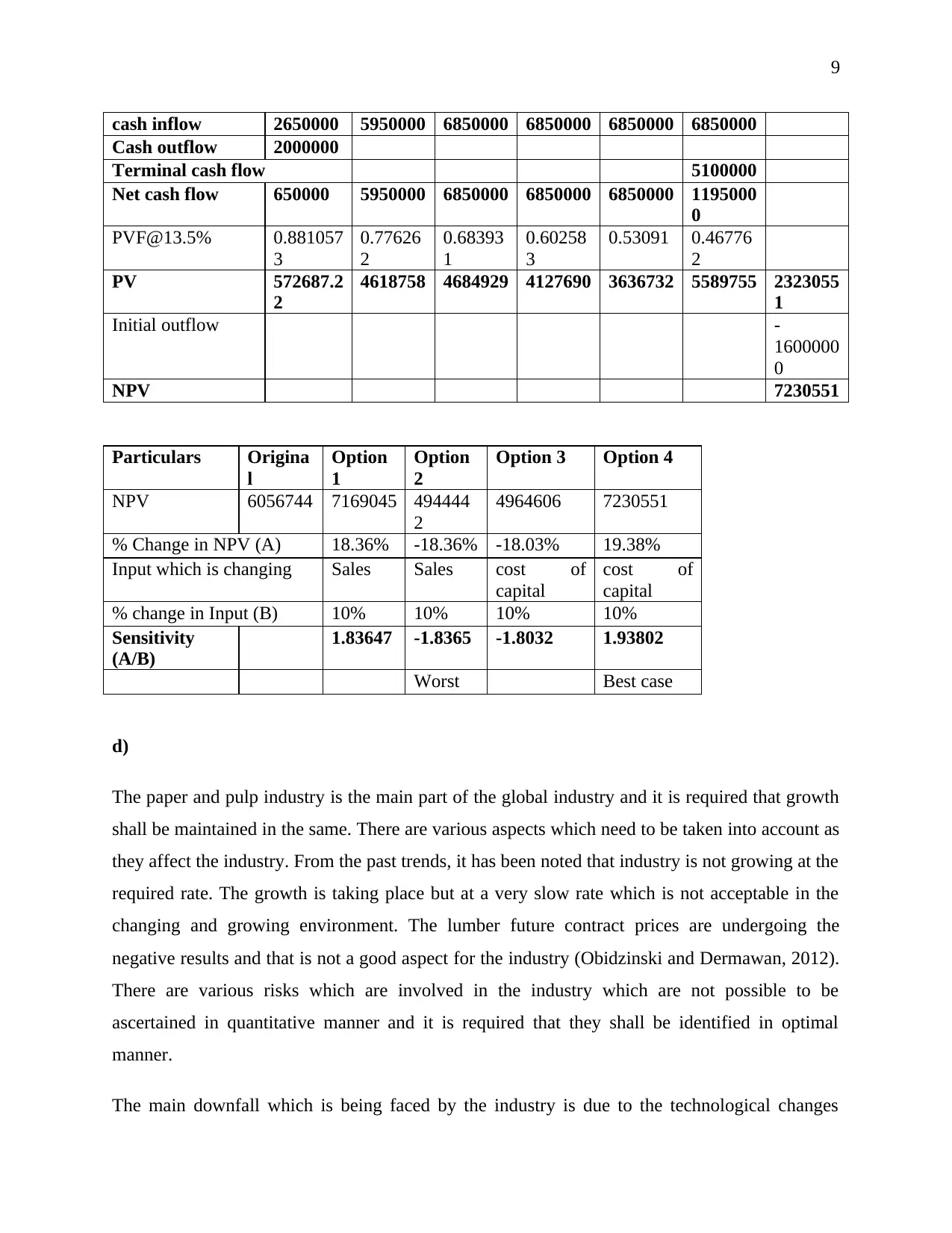
9
cash inflow 2650000 5950000 6850000 6850000 6850000 6850000
Cash outflow 2000000
Terminal cash flow 5100000
Net cash flow 650000 5950000 6850000 6850000 6850000 1195000
0
PVF@13.5% 0.881057
3
0.77626
2
0.68393
1
0.60258
3
0.53091 0.46776
2
PV 572687.2
2
4618758 4684929 4127690 3636732 5589755 2323055
1
Initial outflow -
1600000
0
NPV 7230551
Particulars Origina
l
Option
1
Option
2
Option 3 Option 4
NPV 6056744 7169045 494444
2
4964606 7230551
% Change in NPV (A) 18.36% -18.36% -18.03% 19.38%
Input which is changing Sales Sales cost of
capital
cost of
capital
% change in Input (B) 10% 10% 10% 10%
Sensitivity
(A/B)
1.83647 -1.8365 -1.8032 1.93802
Worst Best case
d)
The paper and pulp industry is the main part of the global industry and it is required that growth
shall be maintained in the same. There are various aspects which need to be taken into account as
they affect the industry. From the past trends, it has been noted that industry is not growing at the
required rate. The growth is taking place but at a very slow rate which is not acceptable in the
changing and growing environment. The lumber future contract prices are undergoing the
negative results and that is not a good aspect for the industry (Obidzinski and Dermawan, 2012).
There are various risks which are involved in the industry which are not possible to be
ascertained in quantitative manner and it is required that they shall be identified in optimal
manner.
The main downfall which is being faced by the industry is due to the technological changes
cash inflow 2650000 5950000 6850000 6850000 6850000 6850000
Cash outflow 2000000
Terminal cash flow 5100000
Net cash flow 650000 5950000 6850000 6850000 6850000 1195000
0
PVF@13.5% 0.881057
3
0.77626
2
0.68393
1
0.60258
3
0.53091 0.46776
2
PV 572687.2
2
4618758 4684929 4127690 3636732 5589755 2323055
1
Initial outflow -
1600000
0
NPV 7230551
Particulars Origina
l
Option
1
Option
2
Option 3 Option 4
NPV 6056744 7169045 494444
2
4964606 7230551
% Change in NPV (A) 18.36% -18.36% -18.03% 19.38%
Input which is changing Sales Sales cost of
capital
cost of
capital
% change in Input (B) 10% 10% 10% 10%
Sensitivity
(A/B)
1.83647 -1.8365 -1.8032 1.93802
Worst Best case
d)
The paper and pulp industry is the main part of the global industry and it is required that growth
shall be maintained in the same. There are various aspects which need to be taken into account as
they affect the industry. From the past trends, it has been noted that industry is not growing at the
required rate. The growth is taking place but at a very slow rate which is not acceptable in the
changing and growing environment. The lumber future contract prices are undergoing the
negative results and that is not a good aspect for the industry (Obidzinski and Dermawan, 2012).
There are various risks which are involved in the industry which are not possible to be
ascertained in quantitative manner and it is required that they shall be identified in optimal
manner.
The main downfall which is being faced by the industry is due to the technological changes
⊘ This is a preview!⊘
Do you want full access?
Subscribe today to unlock all pages.

Trusted by 1+ million students worldwide

10
which are taking place. The companies in this industry are using old technology in the current
scenario also. They are not developed as per the requirements and due to that the production is
affected greatly (Meleo, 2014). In such companies the raw material which will be required for
the production and the time which is consumed in the same is high. There are various processes
which are involved and the carrying out of them covers consumption of more time in comparison
to the latest technologies. Also the quality is hampered with the low-quality raw material and
there is not the sufficient availability of the same. The technology is changing at fast pace and it
becomes difficult to compete with it and keep the updates regarding all the innovations which are
taking place. This leads to the use of the outdated technology which affects the growth of the
industry in negative manner.
Climatic change is another factor which is responsible for the declining growth. With the adverse
weather conditions, the wildlife and forests both are affected in negative manner. The trees are
the main source of the raw material to make paper and with the climatic change they are affected
and destroyed (Mckinsey, 2019). This leads to the shortfall of the raw material which is required.
The raw material in such circumstances is available at high cost which is not beneficial for the
companies and they avoid production due to the same. In the changing climate the wildlife is
affected as their habitat is destroyed. They do not get the proper food on which they can survive
or the place to live. This leads to their reduction or extinction which again affects the industry in
negative manner. There are various reasons for such climate conditions such as the changing
lifestyle of humans by which global warming is taking place.
With the change in the world, there are increased interventions by the government. They frame
various rules and regulations which need to be followed by all. In them there are various related
to the environment and forest safety (Environmental paper, 2018). There are many restrictions
which are placed in them in relation to the various activities which are performed in the forests.
The cutting of the trees is banned and also the wildlife is protected under law. Due to this the
main source of the requirements is affected and there is less availability of the raw material. The
companies dealing in this industry are required to comply with the laws and that imposes various
limitations on them. They are not able to acquire the required resources in adequate quantity and
with that the demand in the market is not fulfilled and the growth is declined.
which are taking place. The companies in this industry are using old technology in the current
scenario also. They are not developed as per the requirements and due to that the production is
affected greatly (Meleo, 2014). In such companies the raw material which will be required for
the production and the time which is consumed in the same is high. There are various processes
which are involved and the carrying out of them covers consumption of more time in comparison
to the latest technologies. Also the quality is hampered with the low-quality raw material and
there is not the sufficient availability of the same. The technology is changing at fast pace and it
becomes difficult to compete with it and keep the updates regarding all the innovations which are
taking place. This leads to the use of the outdated technology which affects the growth of the
industry in negative manner.
Climatic change is another factor which is responsible for the declining growth. With the adverse
weather conditions, the wildlife and forests both are affected in negative manner. The trees are
the main source of the raw material to make paper and with the climatic change they are affected
and destroyed (Mckinsey, 2019). This leads to the shortfall of the raw material which is required.
The raw material in such circumstances is available at high cost which is not beneficial for the
companies and they avoid production due to the same. In the changing climate the wildlife is
affected as their habitat is destroyed. They do not get the proper food on which they can survive
or the place to live. This leads to their reduction or extinction which again affects the industry in
negative manner. There are various reasons for such climate conditions such as the changing
lifestyle of humans by which global warming is taking place.
With the change in the world, there are increased interventions by the government. They frame
various rules and regulations which need to be followed by all. In them there are various related
to the environment and forest safety (Environmental paper, 2018). There are many restrictions
which are placed in them in relation to the various activities which are performed in the forests.
The cutting of the trees is banned and also the wildlife is protected under law. Due to this the
main source of the requirements is affected and there is less availability of the raw material. The
companies dealing in this industry are required to comply with the laws and that imposes various
limitations on them. They are not able to acquire the required resources in adequate quantity and
with that the demand in the market is not fulfilled and the growth is declined.
Paraphrase This Document
Need a fresh take? Get an instant paraphrase of this document with our AI Paraphraser
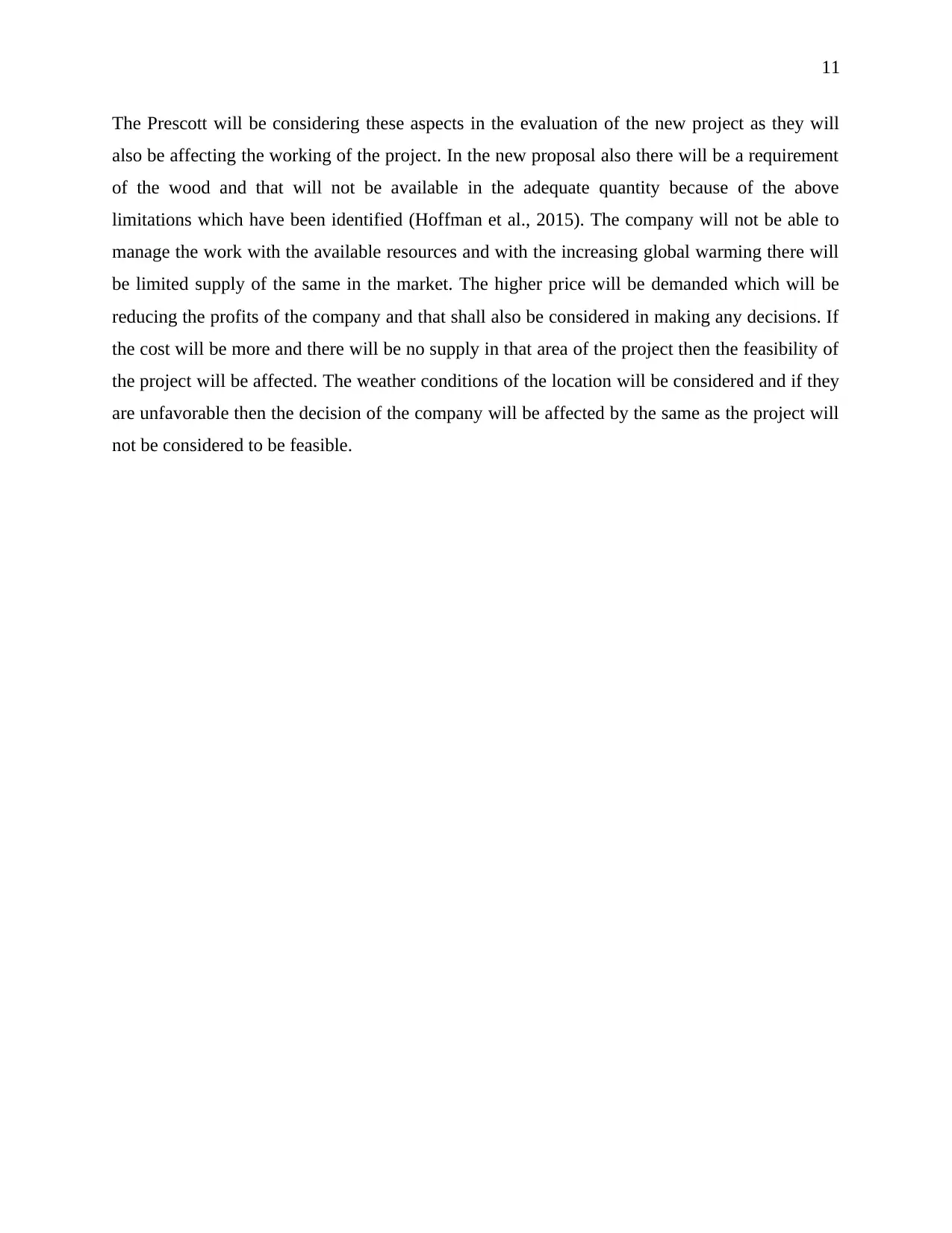
11
The Prescott will be considering these aspects in the evaluation of the new project as they will
also be affecting the working of the project. In the new proposal also there will be a requirement
of the wood and that will not be available in the adequate quantity because of the above
limitations which have been identified (Hoffman et al., 2015). The company will not be able to
manage the work with the available resources and with the increasing global warming there will
be limited supply of the same in the market. The higher price will be demanded which will be
reducing the profits of the company and that shall also be considered in making any decisions. If
the cost will be more and there will be no supply in that area of the project then the feasibility of
the project will be affected. The weather conditions of the location will be considered and if they
are unfavorable then the decision of the company will be affected by the same as the project will
not be considered to be feasible.
The Prescott will be considering these aspects in the evaluation of the new project as they will
also be affecting the working of the project. In the new proposal also there will be a requirement
of the wood and that will not be available in the adequate quantity because of the above
limitations which have been identified (Hoffman et al., 2015). The company will not be able to
manage the work with the available resources and with the increasing global warming there will
be limited supply of the same in the market. The higher price will be demanded which will be
reducing the profits of the company and that shall also be considered in making any decisions. If
the cost will be more and there will be no supply in that area of the project then the feasibility of
the project will be affected. The weather conditions of the location will be considered and if they
are unfavorable then the decision of the company will be affected by the same as the project will
not be considered to be feasible.
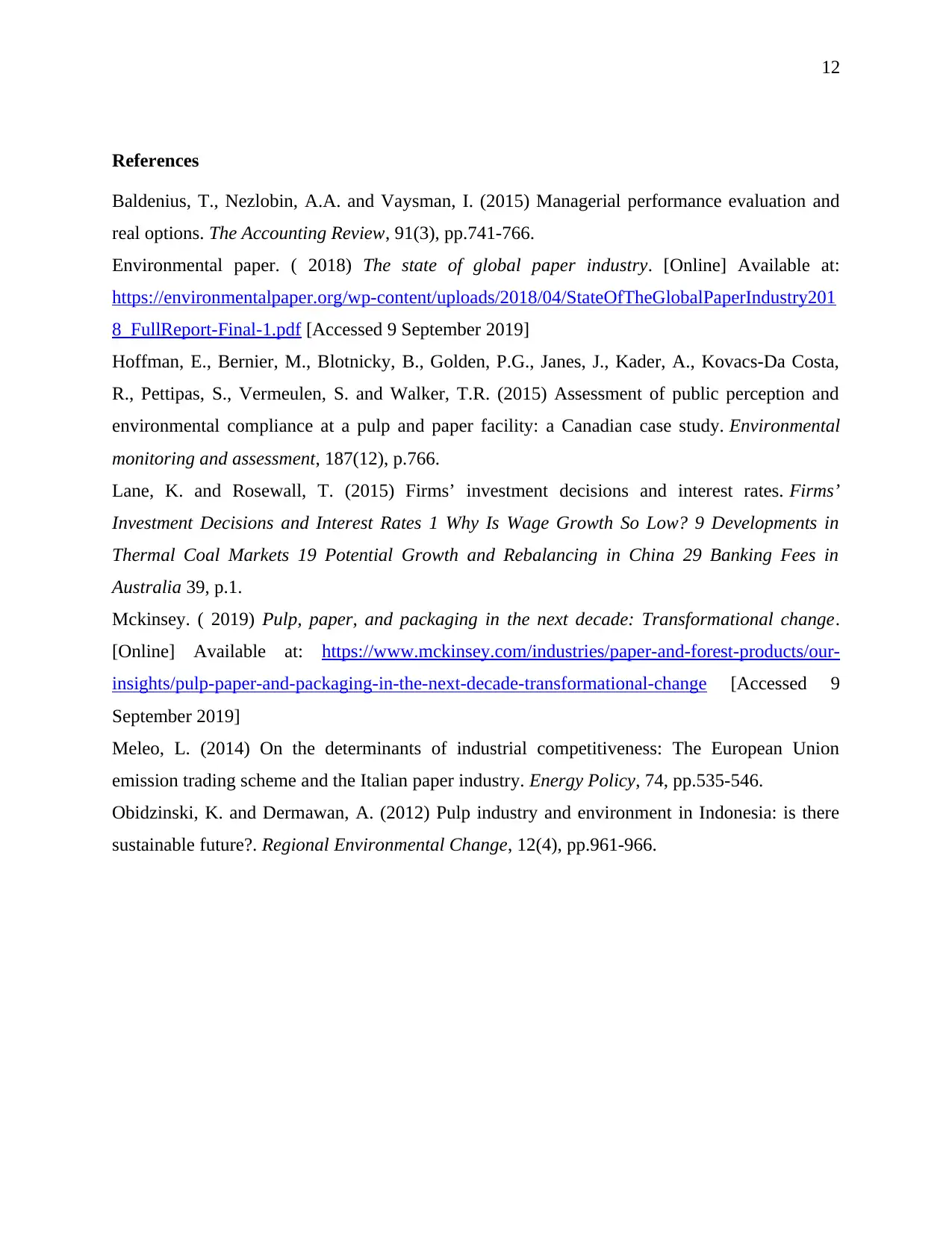
12
References
Baldenius, T., Nezlobin, A.A. and Vaysman, I. (2015) Managerial performance evaluation and
real options. The Accounting Review, 91(3), pp.741-766.
Environmental paper. ( 2018) The state of global paper industry. [Online] Available at:
https://environmentalpaper.org/wp-content/uploads/2018/04/StateOfTheGlobalPaperIndustry201
8_FullReport-Final-1.pdf [Accessed 9 September 2019]
Hoffman, E., Bernier, M., Blotnicky, B., Golden, P.G., Janes, J., Kader, A., Kovacs-Da Costa,
R., Pettipas, S., Vermeulen, S. and Walker, T.R. (2015) Assessment of public perception and
environmental compliance at a pulp and paper facility: a Canadian case study. Environmental
monitoring and assessment, 187(12), p.766.
Lane, K. and Rosewall, T. (2015) Firms’ investment decisions and interest rates. Firms’
Investment Decisions and Interest Rates 1 Why Is Wage Growth So Low? 9 Developments in
Thermal Coal Markets 19 Potential Growth and Rebalancing in China 29 Banking Fees in
Australia 39, p.1.
Mckinsey. ( 2019) Pulp, paper, and packaging in the next decade: Transformational change.
[Online] Available at: https://www.mckinsey.com/industries/paper-and-forest-products/our-
insights/pulp-paper-and-packaging-in-the-next-decade-transformational-change [Accessed 9
September 2019]
Meleo, L. (2014) On the determinants of industrial competitiveness: The European Union
emission trading scheme and the Italian paper industry. Energy Policy, 74, pp.535-546.
Obidzinski, K. and Dermawan, A. (2012) Pulp industry and environment in Indonesia: is there
sustainable future?. Regional Environmental Change, 12(4), pp.961-966.
References
Baldenius, T., Nezlobin, A.A. and Vaysman, I. (2015) Managerial performance evaluation and
real options. The Accounting Review, 91(3), pp.741-766.
Environmental paper. ( 2018) The state of global paper industry. [Online] Available at:
https://environmentalpaper.org/wp-content/uploads/2018/04/StateOfTheGlobalPaperIndustry201
8_FullReport-Final-1.pdf [Accessed 9 September 2019]
Hoffman, E., Bernier, M., Blotnicky, B., Golden, P.G., Janes, J., Kader, A., Kovacs-Da Costa,
R., Pettipas, S., Vermeulen, S. and Walker, T.R. (2015) Assessment of public perception and
environmental compliance at a pulp and paper facility: a Canadian case study. Environmental
monitoring and assessment, 187(12), p.766.
Lane, K. and Rosewall, T. (2015) Firms’ investment decisions and interest rates. Firms’
Investment Decisions and Interest Rates 1 Why Is Wage Growth So Low? 9 Developments in
Thermal Coal Markets 19 Potential Growth and Rebalancing in China 29 Banking Fees in
Australia 39, p.1.
Mckinsey. ( 2019) Pulp, paper, and packaging in the next decade: Transformational change.
[Online] Available at: https://www.mckinsey.com/industries/paper-and-forest-products/our-
insights/pulp-paper-and-packaging-in-the-next-decade-transformational-change [Accessed 9
September 2019]
Meleo, L. (2014) On the determinants of industrial competitiveness: The European Union
emission trading scheme and the Italian paper industry. Energy Policy, 74, pp.535-546.
Obidzinski, K. and Dermawan, A. (2012) Pulp industry and environment in Indonesia: is there
sustainable future?. Regional Environmental Change, 12(4), pp.961-966.
⊘ This is a preview!⊘
Do you want full access?
Subscribe today to unlock all pages.

Trusted by 1+ million students worldwide
1 out of 12
Your All-in-One AI-Powered Toolkit for Academic Success.
+13062052269
info@desklib.com
Available 24*7 on WhatsApp / Email
![[object Object]](/_next/static/media/star-bottom.7253800d.svg)
Unlock your academic potential
Copyright © 2020–2025 A2Z Services. All Rights Reserved. Developed and managed by ZUCOL.